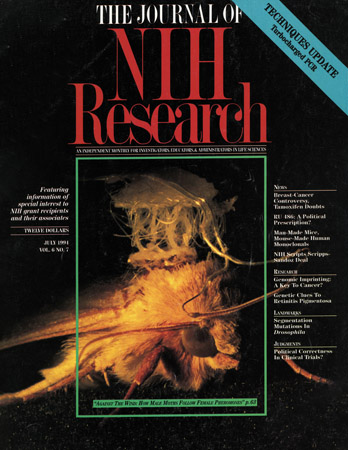
Biology Under Cover
Selected Journal & Book Covers from SBS Faculty
"Research Brief: Against the Wind: How Male Moths Follow Female Pheromones"
Photo: N.J. Vickers
Commentary
This cover photo shows a male tobacco budworm moth outfitted with a small piece of Velcro holding an attached antenna from a different male. Fine wires placed in either end of the antenna allowed electrical signals to berecorded as they occur when the antenna contacts female moth odors known as pheromones. As the male transporting the extra antenna flew in a pheromone plume, we were able to see when it intercepted pockets of pheromone and how these encounters shaped the flight behavior of the males. The article accompanying this cover picture reviewed the original work. (No PDF of article available.)Photo: N.J. Vickers
Article referenced/reviewed
Article referenced/reviewed:Vickers NJ, Baker TC. Reiterative responses to single strands of odor promote sustained upwind flight and odor source location by moths. Proceedings of the National Academy of Science USA. Vol. 91 5756-5760, June 1994
Abstract
We summarize work on a speciose Neotropical tree genus,Inga(Fabaceae), examining how interspecific variation in anti-herbivore defenses may have evolved, how defenses shape host choice by herbivores and how they might regulate community composition and influence species radiations. Defenses of expanding leaves include secondary metabolites, extrafloral nectaries, rapid leaf expansion, trichomes, and synchrony and timing of leaf production. These six classes of defenses are orthogonal, supporting independent evolutionary trajectories. Moreover, only trichomes show a phylogenetic signature, suggesting evolutionary lability in nearly all defenses. The interspecific diversity in secondary metabolite profiles does not arise from the evolution of novel (cont.) compounds, but from novel combinations of common compounds, presumably due to changes in gene regulation. Herbivore host choice is determined by plant defensive traits, not host phylogeny. Neighboring plants escape each other’s pests if their defenses differ enough, thereby enforcing the high local diversity typical of tropical forests. Related herbivores feed on hosts with similar defenses, implying that there are phylogenetic constraints placed on the herbivore traits that are associated with host use. Divergence in defensive traits amongIngaappears to be drivenby herbivore pressure. However, the lack of congruence between herbivore and host phylogeny suggests that herbivores are tracking defenses, choosing hosts based on traits for which they already have adaptations. There is, therefore, an asymmetry in the host–herbivore evolutionary arms race.
